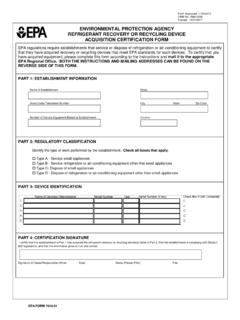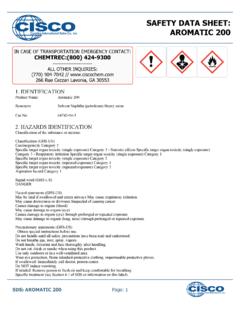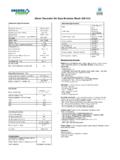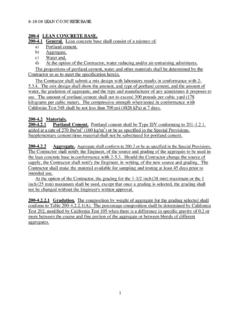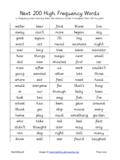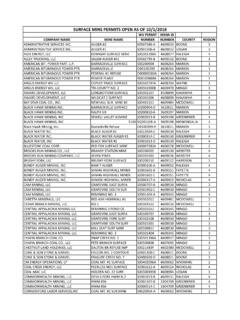Transcription of Method 200.7, Revision 4.4: Determination of Metals …
1 1994 Method , Revision : Determination of Metals and trace Elements in Water and Wastes by Inductively Coupled Plasma-Atomic Emission Spectrometry Method Determination OF Metals AND trace ELEMENTS IN WATER AND WASTES BY INDUCTIVELY COUPLED PLASMA-ATOMIC EMISSION SPECTROMETRY Revision EMMC Version USEPA-ICP Users Group (Edited by Martin and Kopp) - Method , Revision , (Printed 1979, Published 1982) Martin and Martin - Method , Revision (1990) Martin, Brockhoff, Creed, and Long (Technology Applications Inc.) - Method , Revision (1991) Martin, Brockhoff, Creed, and EMMC Methods Work Group - Method , Revision (1994) ENVIRONMENTAL MONITORING SYSTEMS LABORATORY OFFICE OF RESEARCH AND DEVELOPMENT U. S. ENVIRONMENTAL PROTECTION AGENCY CINCINNATI, OHIO 45268 Method Determination OF Metals AND trace ELEMENTS IN WATER AND WASTES BY INDUCTIVELY COUPLED PLASMA-ATOMIC EMISSION SPECTROMETRY SCOPE AND APPLICATION Inductively coupled plasma-atomic emission spectrometry (ICP-AES) is used to determine Metals and some nonmetals in solution.
2 This Method is a consolidation of existing methods for water, wastewater, and solid (For analysis of petroleum products see References 5 and 6, Section ) This Method is applicable to the following analytes: Chemical Abstract Services Analyte Registry Number (CASRN) Aluminum (Al) 7429-90-5 Antimony (Sb) 7440-36-0 Arsenic (As) 7440-38-2 Barium (Ba) 7440-39-3 Beryllium (Be) 7440-41-7 Boron (B) 7440-42-8 Cadmium (Cd) 7440-43-9 Calcium (Ca) 7440-70-2 Ceriuma (Cr) 7440-45-1 Chromium (Cr) 7440-47-3 Cobalt (Co) 7440-48-4 Copper (Cu) 7440-50-8 Iron (Fe) 7439-89-6 Lead (Pb) 7439-92-1 Lithium (Li) 7439-93-2 Magnesium (Mg) 7439-95-4 Manganese (Mn) 7439-96-5 Mercury (Hg) 7439-97-6 Molybdenum (Mo) 7439-98-7 Nickel (Ni) 7440-02-0 Phosphorus (P) 7723-14-0 Potassium (K) 7440-09-7 Selenium (Se) 7782-49-2 Silicab (SiO ) 2 7631-86-9 Silver (Ag) 7440-22-4 aCerium has been included as Method analyte for correction of potential interelement spectral interference.
3 BThis Method is not suitable for the Determination of silica in solids. Chemical Abstract Services Analyte Registry Number (CASRN) Sodium (Na) 7440-23-5 Strontium (Sr) 7440-24-6 Thallium (Tl) 7440-28-0 Tin (Sn) 7440-31-5 Titanium (Ti) 7440-32-6 Vanadium (V) 7440-62-2 Zinc (Zn) 7440-66-6 For reference where this Method is approved for use in compliance monitoring programs [ , Clean Water Act (NPDES) or Safe Drinking Water Act (SDWA)] consult both the appropriate sections of the Code of Federal Regulation (40 CFR Part 136 Table 1B for NPDES, and Part 141 for drinking water), and the latest Federal Register announcements. ICP-AES can be used to determine dissolved analytes in aqueous samples after suitable filtration and acid preservation. To reduce potential interferences, dissolved solids should be < (w/v) (Section ). With the exception of silver, where this Method is approved for the Determination of certain metal and metalloid contaminants in drinking water, samples may be analyzed directly by pneumatic nebulization without acid digestion if the sample has been properly preserved with acid and has turbidity of <1 NTU at the time of analysis.
4 This total recoverable Determination procedure is referred to as "direct analysis". However, in the Determination of some primary drinking water metal contaminants, preconcentration of the sample may be required prior to analysis in order to meet drinking water acceptance performance criteria (Sections through ). For the Determination of total recoverable analytes in aqueous and solid samples a digestion/extraction is required prior to analysis when the elements are not in solution ( , soils, sludges, sediments and aqueous samples that may contain particulate and suspended solids). Aqueous samples containing suspended or particulate material 1% (w/v) should be extracted as a solid type sample. When determining boron and silica in aqueous samples, only plastic, PTFE or quartz labware should be used from time of sample collection to completion of analysis.
5 For accurate Determination of boron in solid samples only quartz or PTFE beakers should be used during acid extraction with immediate transfer of an extract aliquot to a plastic centrifuge tube following dilution of the extract to volume. When possible, borosilicate glass should be avoided to prevent contamination of these analytes. Silver is only slightly soluble in the presence of chloride unless there is a sufficient chloride concentration to form the soluble chloride complex. Therefore, low recoveries of silver may occur in samples, fortified sample matrices and even fortified blanks if determined as a dissolved analyte or by "direct analysis" where the sample has not been processed using the total recoverable mixed acid digestion. For this reason it is recommended that samples be digested prior to the Determination of silver. The total recoverable sample digestion procedure given in this Method is suitable for the Determination of silver in aqueous samples containing concentrations up to mg/L.
6 For the analysis of wastewater samples containing higher concentrations of silver, succeeding smaller volume, well mixed aliquots should be prepared until the analysis solution contains < mg/L silver. The extraction of solid samples containing concentrations of silver >50 mg/kg should be treated in a similar manner. Also, the extraction of tin from solid samples should be prepared again using aliquots <1 g when determined sample concentrations exceed 1%. The total recoverable sample digestion procedure given in this Method will solubilize and hold in solution only minimal concentrations of barium in the presence of free sulfate. For the analysis of barium in samples having varying and unknown concentrations of sulfate, analysis should be completed as soon as possible after sample preparation. The total recoverable sample digestion procedure given in this Method is not suitable for the Determination of volatile organo-mercury compounds.
7 However, if digestion is not required (turbidity <1 NTU), the combined concentrations of inorganic and organo-mercury in solution can be determined by "direct analysis" pneumatic nebulization provided the sample solution is adjusted to contain the same mixed acid (HNO + HCl) matrix as the total3 recoverable calibration standards and blank solutions. Detection limits and linear ranges for the elements will vary with the wavelength selected, the spectrometer, and the matrices. Table 1 provides estimated instrument detection limits for the listed However, actual Method detection limits and linear working ranges will be dependent on the sample matrix, instrumentation, and selected operating conditions. Users of the Method data should state the data-quality objectives prior to analysis. Users of the Method must document and have on file the required initial demonstration performance data described in Section prior to using the Method for analysis.
8 SUMMARY OF Method An aliquot of a well mixed, homogeneous aqueous or solid sample is accurately weighed or measured for sample processing. For total recoverable analysis of a solid or an aqueous sample containing undissolved material, analytes are first solubilized by gentle refluxing with nitric and hydrochloric acids. After cooling, the sample is made up to volume, is mixed and centrifuged or allowed to settle overnight prior to analysis. For the Determination of dissolved analytes in a filtered aqueous sample aliquot, or for the "direct analysis" total recoverable Determination of analytes in drinking water where sample turbidity is <1 NTU, the sample is made ready for analysis by the appropriate addition of nitric acid, and then diluted to a predetermined volume and mixed before analysis. The analysis described in this Method involves multielemental determinations by ICP-AES using sequential or simultaneous instruments.
9 The instruments measure characteristic atomic-line emission spectra by optical spectrometry. Samples are nebulized and the resulting aerosol is transported to the plasma torch. Element specific emission spectra are produced by a radio-frequency inductively coupled plasma. The spectra are dispersed by a grating spectrometer, and the intensities of the line spectra are monitored at specific wavelengths by a photosensitive device. Photocurrents from the photosensitive device are processed and controlled by a computer system. A background correction technique is required to compensate for variable background contribution to the Determination of the analytes. Background must be measured adjacent to the analyte wavelength during analysis. Various interferences must be considered and addressed appropriately as discussed in Sections , , , , and DEFINITIONS Calibration Blank - A volume of reagent water acidified with the same acid matrix as in the calibration standards.
10 The calibration blank is a zero standard and is used to calibrate the ICP instrument (Section ). Calibration Standard (CAL) - A solution prepared from the dilution of stock standard solutions. The CAL solutions are used to calibrate the instrument response with respect to analyte concentration (Section ). Dissolved Analyte - The concentration of analyte in an aqueous sample that will pass through a m membrane filter assembly prior to sample acidification (Section ). Field Reagent Blank (FRB) - An aliquot of reagent water or other blank matrix that is placed in a sample container in the laboratory and treated as a sample in all respects, including shipment to the sampling site, exposure to the sampling site conditions, storage, preservation, and all analytical procedures. The purpose of the FRB is to determine if Method analytes or other interferences are present in the field environment (Section ).









